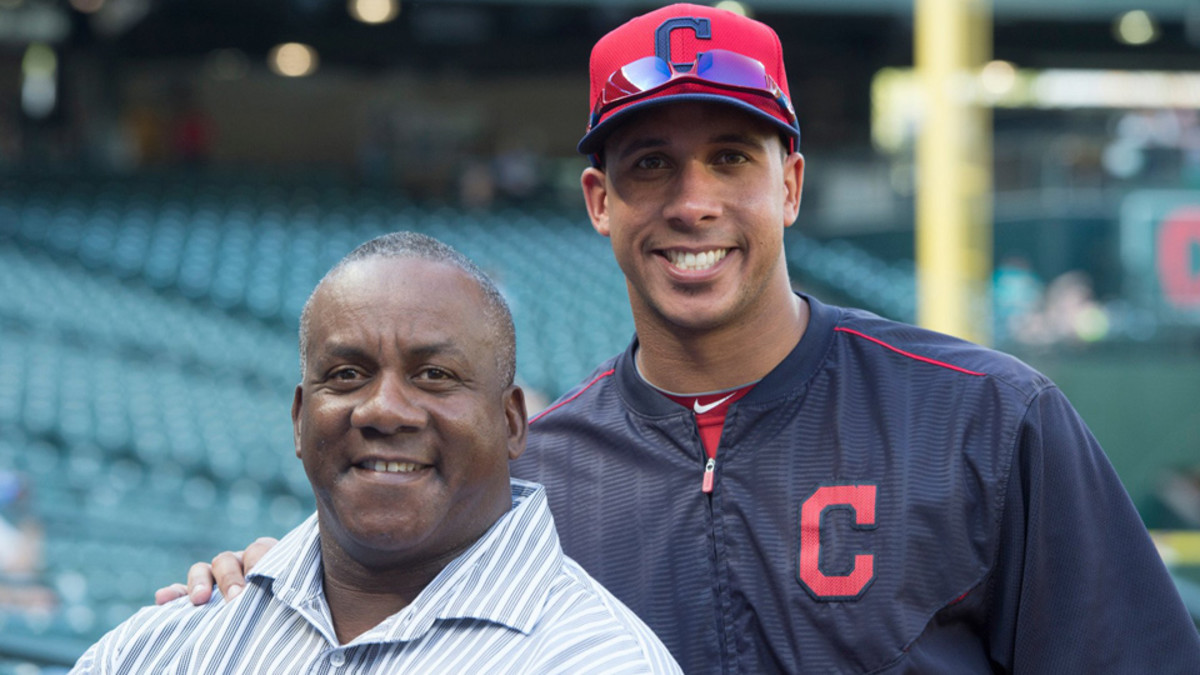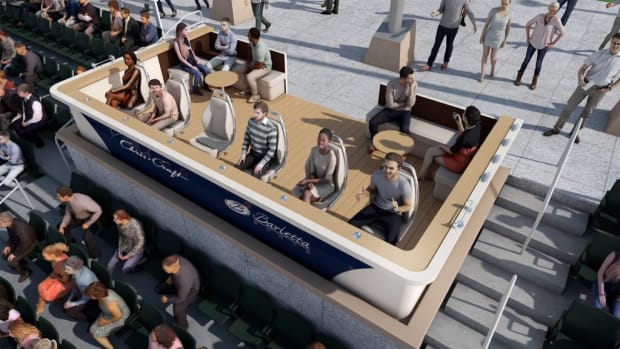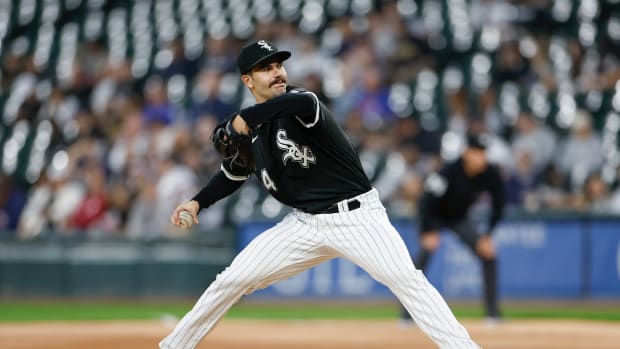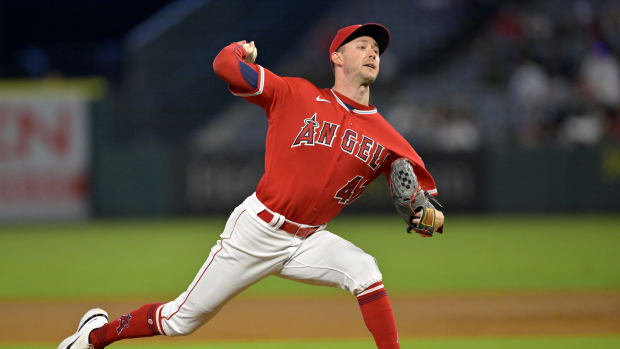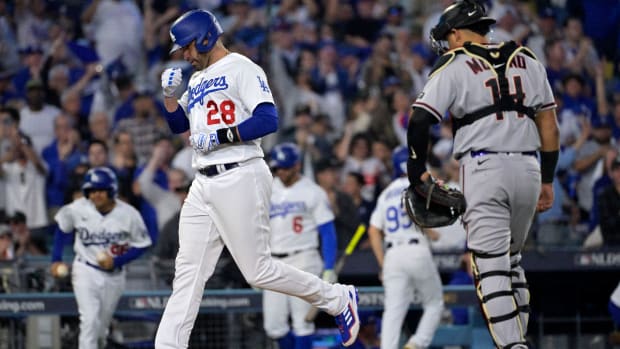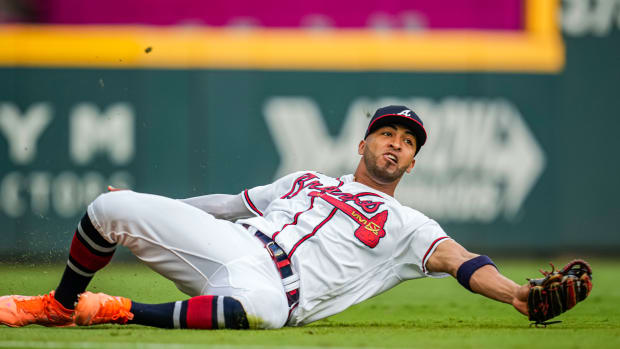The Sixth Tool: How Michael Brantley and his father built an MVP swing
This story appears in the June 22, 2015 issue of SPORTS ILLUSTRATED. To subscribe, click here.
For the two days before Christmas of 1997, Michael Brantley and his younger sister, BriAnna, could not see through the windows of the back of their family’s house in Port St. Lucie, Fla. Their parents, Mickey and Nina, had taped them up, though the children could hear their father and a few of his friends banging around back there. Finally, Christmas morning arrived, and they were permitted to run out to their yard. There was a trampoline for BriAnna. For Michael, who was 10, there was a batting cage.
“I went in there and hit forever,” Michael says. “I loved it.”
Christmases were never so extravagant for Mickey when he was young. He grew up the sixth of 11 children—seven boys, four girls—in the blue-collar town of Catskill, N.Y. His father was a foundry worker, and his mother had the even more difficult job of keeping everyone clothed and fed. Even so, there was always extra room at the Brantley table, including, for a time in the early 1980s, for a teenage boxer named Mike Tyson, whose trainer had brought him to upstate New York to keep him out of the trouble he kept getting into back home in Brooklyn.
When he was nine, Mickey took on a paper route, rising at five each morning before school to trudge up and down snowy hills to deliver the Catskill Daily Mail. “We needed money,” he says, 44 years later. “Everyone chipped in. You weren’t going to outwork us.”
Mickey had more than a willingness to work. He also had superior athletic skill and the desire to see where that combination might take him. At 5'10", he could do everything there was to do on a baseball field—hit for average, hit for power, run, catch, throw—and he earned a scholarship to Coastal Carolina, near Myrtle Beach, S.C. In 1983, the Mariners made him their second-round pick in the draft.
Thanks to his work behind plate, Cervelli is Pirates' quiet MVP
Mickey’s work ethic persisted, but his abilities did not. Over the years his body broke down, his tools carved out of him by time and fate. He snapped his right ankle rounding third base in college; his speed was never quite the same. He broke his right wrist in the minors; his swing was never quite the same. He shattered his collarbone running headfirst into a wooden outfield wall at Triple A Calgary; his arm was never quite the same. Though he made the big leagues and batted .302 with 14 homers and 13 steals in 1987, his first full season, by the time he was 28, his centerfield job was gone, taken by a 19-year-old named Ken Griffey Jr. Mickey’s last appearance with the Mariners was in 1989. He would spend time in the minor-league systems of five other clubs, and a few months in Japan, but he never played in the majors again.
Mickey understood everything it took to excel in baseball, even if his body would no longer allow him to do so. So he became a hitting coach, in the minors for the Giants and the Mets between 1994 and 2004, and then for the Blue Jays between 2005 and ’07. His greatest pupil, though, was Michael, born to him and Nina in 1987.
Mickey knew he would be delighted if his son followed in his footsteps. “It’s the greatest experience you can possibly have,” says Mickey, who speaks as quickly as he used to run. “You get a chance to live the dream.” Unlike many sports-minded fathers, however, he refused to push his son toward it, even as Michael began to show the same five tools that his father once had. The desire had to come from Michael himself.
Michael had the desire. In 2005, when he was as an 18-year-old Florida high schooler, the Brewers made him a seventh-round draft pick. Three years later, in 2008, he was the player to be named later in the blockbuster midsummer trade that sent CC Sabathia from the Indians to the Brewers. A young slugger named Matt LaPorta was supposed to be the Indians’ prize in that deal—he had recently been ranked as the game’s 23rd best prospect on Baseball America’s Top 100 list, a list Michael never made—but it did not turn out that way. LaPorta batted .238 with 31 home runs in parts of four major league seasons; he retired from baseball in April at the age of 30. Last season, at 27, Michael batted .327, with 20 home runs, 97 RBIs and 23 steals as the Indians’ everyday leftfielder, and finished third in the voting for American League MVP.
Rival scouts will claim they saw Michael Brantley coming. “It’s no surprise to us in the scouting profession that he had a year like that,” one says. “He doesn’t hit 500-foot home runs, but he might hit more line drives than any hitter in baseball. To me, he seems to slow the game down when it’s a big situation; he knows he has good mechanics and knows what he needs to do.”
But even the Indians couldn’t have confidently predicted that Brantley would become a near-MVP, especially not when they traded for him. “There were a lot of things our scouts and analysts liked: his body, his athleticism, the way he controlled the strike zone,” general manager Chris Antonetti says. “But anyone who says they know what a player’s going to become—it’s not true.”
Michael Brantley, as it turned out, had more than the desire to maximize his five tools. He had a sixth tool too, one whose impact on his career was more difficult for the Indians and their rivals to project than his foot speed and his throwing arm. His sixth tool was Mickey.
*****
Mickey’s rules for working with his son in their backyard cage were simple. “Michael,” he told him, “we can do this all day if you’re serious about it. If you want to go out and start fooling around, your dad doesn’t have time for that.” Michael never fooled around. “My dad never forced me one time to go hit,” says Michael. “He always told me to enjoy it. Whenever I come off the field, the first thing he asks is if I had fun. He never embarrassed me on the field, never yelled to me from the stands, not once.”
Awards Watch: Billy Burns emerges as new leader in AL Rookie race
The cage was equipped with a pitching machine. It was not just the same kind that Keith Hernandez and Darryl Strawberry had once used just up the road at the Mets’ spring training complex, but the very same one. It was a decade old, and when the Mets were throwing it away in favor of a newer model, Mickey, then the club’s minor-league hitting coordinator, asked if he might have it. It was a metal box, the size of a large refrigerator, and on its right side was a spindly, rotating metal arm that could hurl baseballs upward of 65 mph. It vibrated and clanged and whirred, but Mickey believed it was preferable to the modern three-wheeled variety of machine because the pitches it delivered were unpredictable—some in, some out, some up, some down—and its swinging arm better allowed hitters to develop their rhythm. “The one with the wheels will mess up your timing,” says Michael. Adds Mickey, “Timing is everything.”
Scouts today gush over Michael’s simple, compact lefthanded swing, the one that produces so many line drives, but he does not take even most of the credit for it. “He kind of built it,” says Michael of his father. “I helped, because of all the work I put in. But this is a swing that we developed together.”
In the backyard cage, Mickey set about imbuing in Michael’s swing attributes he had picked up from all of the great hitters he had coached during his career. He taught him Barry Bonds’s extreme head turn, which allowed him to track pitches with both eyes (“Most guys are peekers,” says Mickey), and John Olerud’s ability to start to swing at every pitch, only to step out of it with his back foot at the last moment if it wasn’t a good one. The ideal result, to Mickey, was always clear: to hit the back of the cage’s net every time and never the top of it. “I wanted to hit home runs, and he told me no,” Michael says. “‘Learn to hit, and the power will come.’”
When Michael was 15, his idyllic routine of family, school (he had a GPA of 3.85 at Fort Pierce’s Central High) and baseball was shattered when Mickey and Nina got divorced after 17 years of marriage. “It was a very difficult time,” says Michael, who is more deliberate in his speech than his father. (His nickname in Cleveland is Dr. Smooth, and not just for his playing style.) “You love both your parents, but splitting up the household, dad’s house one day, mom’s the next? It was very tough, very challenging. I know a lot of kids go through it.”
Mickey tried to balance his newly tricky fatherhood with the grueling travel his coaching required, but once the Blue Jays let him go in ’07, he decided he’d had enough. He established a private hitting instruction business in Port St. Lucie, largely so he could focus on his now adult children. “I knew they needed me,” he says.
Nolan Arenado has a hot corner style all his own but gets golden results
Michael rose steadily up the minor-league ladder, hitting as Mickey had taught him. He debuted for the Indians in 2009, at 22, and by 2013 his progress seemed to have plateaued: He batted .284, to the previous season’s .288; he hit 10 home runs, to the previous season’s six; and his OPS was .728, to the previous season’s .750. Before last season he finally agreed to do something that Mickey had been encouraging him to do for at least two years: get aggressive.
In the minors and during his first few seasons with Cleveland, Michael had been a leadoff hitter and felt obligated to carry a leadoff hitter’s mindset. “Working the count, getting on base, walking, making sure I see enough pitches,” he says. “I was a defensive hitter.”
Mickey thought Michael was ready to become a middle-of-the-order force. “He was like, ‘Son, I promise you, if you go to a more aggressive approach, your numbers will only go up.’ I tried it.”
Over his first five big-league seasons, Brantley had just 62 first-pitch hits. Last year, he had 40, more than all but five other players. He also had 45 doubles in addition to his 20 homers, and no one had more extra-base hits than his 67 while also striking out fewer than his 56 times. “You don’t have to swing at the first pitch,” Mickey had told him, “but you have to be ready to hit it.”
*****
Metallic pings cut through the quiet of a residential neighborhood in Port St. Lucie one afternoon this spring, reverberating off the roofs of ranch-style houses. Mickey spends his days running travel ball teams with a nonprofit called All American Prospects and conducting private lessons, though not in the cage he once built for Michael. That house was sold after the divorce; Mickey and Nina moved into separate abodes, neither of them far from the home where Michael lives during the off-season with his wife and three children. Mickey now gives his lessons in a cage located in the yard of friends of his, Debbie and Steve Douthitt. The Mets’ old pitching machine, called an Iron Mike, sits covered under a tarp; on this day, Mickey’s student, an eight-year-old named Boden, was too young for its unpredictable fastballs.
“I’ll tell you this,” Mickey said, as he flipped underhanded pitches to Boden. “Boden’s tenacious.”
“What’s that mean?” Boden asked.
In the two months after Michael’s breakout season, he and his father did what they always do, which is fish for flounder. “Best-tasting fish in the ocean,” Mickey says. Though they now cast their lines from the deck of Michael’s 24-foot Everglades boat, purchased after he signed a four-year, $25 million contract with the Indians in February 2014, Mickey remains as much a technician about flounder fishing as he is about hitting. “They eat from the tail up, so sometimes it takes two or three minutes before they swallow the whole bait,” he says. “Some people can’t catch flounder, because they feel the initial hit and they pull up, and the flounder’s got only half the bait. You have to wait.”
As usual, Mickey reeled in more fish than Michael, though that is one of the only activities in which he retains an advantage over his son. “I can’t beat him in anything anymore,” says Mickey, proudly. “The only thing I’ve got is fishing. And pool, maybe. Golf, he kills me. We shoot hoops, play H-O-R-S-E, he kills me.”
Cardinals' hacking into Astros' database is worse than Deflategate
By last Thanksgiving, it was time to get back into the cage in the Douthitts’ backyard—first two times a week, then three and then, by January, five. They started with bottom-hand drills, in which Michael would grip a short, heavy bat they’ve nicknamed Fat Albert with only his right hand and hit off a tee, in order to train his path to the ball. Then he would take two-handed swings at the tee, which was sometimes elevated to encourage barrel control. Then they would fire up the Iron Mike. The goal was the same as it had ever been: to strike the ball to the cage’s back net, never its top or sides.
For the 2015 season, Mickey presented Michael with a new goal: to hit the ball the opposite way with power. “I got very comfortable, on fastballs away, hitting a single to left, because I can,” Michael says. “We were talking about staying over the ball and driving it to left center, over the leftfielder’s head.”
It wouldn’t prove to be easy. If Michael had once been overlooked by opposing pitchers, he isn’t anymore. “They’re doing a lot more careful job of pitching to me this year,” Michael says. “I’m getting 3–0 breaking balls, unintentional intentional walks.” Through Sunday, Michael was on pace to draw over 35% more bases on balls, 73, than he ever had before. He was also, however, batting .301, and was second on the Indians with 33 RBIs and in the AL with 19 doubles.
After every game, Michael calls or texts Mickey, who he knows has broken down each of Michael’s at bats frame-by-frame on his DVR, for tips that can now be communicated in shorthand: “hand path,” “feet.” Michael knows that Mickey is willing to hop on the first flight to wherever he is playing to work with him directly, as he has a few times already this season. “I don’t show up to his games, I don’t go out to Cleveland, I’m not part of that system,” Mickey says. “Only time I ever go to see my son is when he calls for his pops.” Mickey usually has to watch no more than five of Michael’s swings to see what has gone wrong.
While clubs have been known to take issue with such parental involvement, the Indians do not object to Mickey’s. “His dad knows his swing better than anybody,” says manager Terry Francona. “That he is a former player and hitting coach certainly helps.”
Mickey will work with Michael’s children—an eight-year-old stepson, who so far has shown more of a passion for football, as well as a 21-month-old daughter and an infant son—but only if they want him to. “Kids love him—they absolutely love him,” says Michael. “It’s a gift he has.” On this afternoon in Port St. Lucie, Mickey was focused on Boden, who swung as his mother and sister watched.
“How you holding up?” Mickey asked, as he sat on an overturned bucket and lobbed pitches in the boy’s direction.
“Good!” Boden said.
“You tired?”
“No!”
“Oh, boy,” Mickey said, grinning. “That means I have to throw more.”
More often than not, Boden’s swings produced line drives that screamed past Mickey’s head and over the tarp-covered Iron Mike, and struck the very back of the batting cage’s net






























